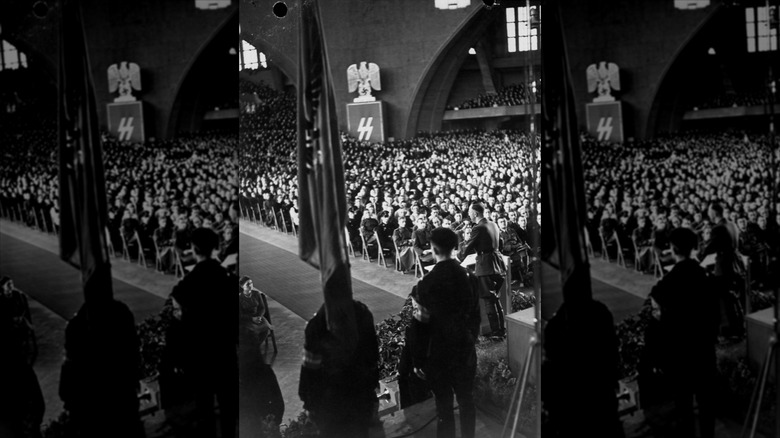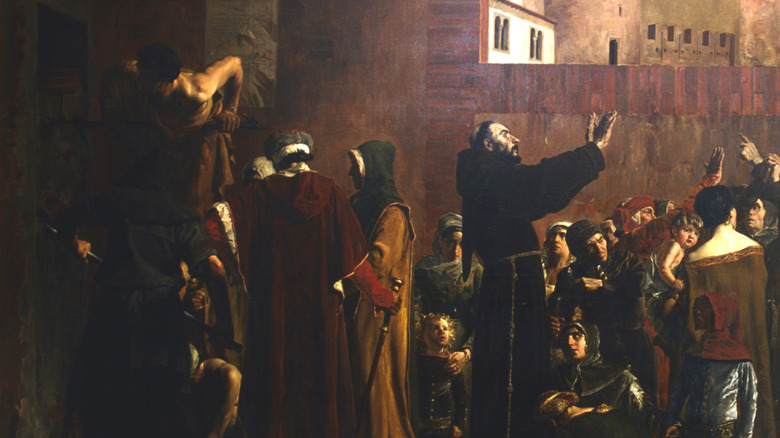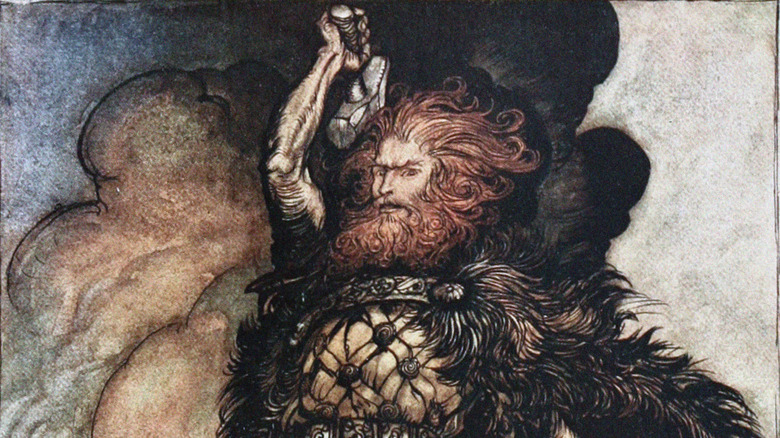Adolf Hitler's Bizarre Hunt For The Holy Grail Explained
When Adolf Hitler transformed Germany into a fascist state in the 1930s, it was with the intention to not only secure ultimate self-empowerment but also to overhaul German culture as it was known to that point. As laid out in Hitler's memoir "Mein Kampf," which he wrote in prison after a failed coup attempt in 1923, the Nazi leader's ideology was based around the concept that the Germanic people were a biological race, known as the Aryans — the definition of which remained slippery throughout the Nazi Party's existence — who required racial purity in society for the state to prosper. Specifically, he outlined that Germany's Jewish population was inferior to those he deemed Aryans, and argued that they must be eliminated. The Nazis would go on to murder 6 million Jews by 1945, around two-thirds of the Jewish population of Europe.
The Nazi genocide was propelled by pre-existing antisemitism in Germany, with Hitler reaching back to the writing of German nationalists such as Georg Ritter von Schönerer, who argued for a mono-ethnic state and preached hatred toward Jews. The loss of World War I saw many people in Germany looking for a scapegoat, a frustration that Hitler successfully tapped into. But despite the fact that there was zero evidence to underpin Hitler's beliefs, SS leader Heimlich Himmler was entrusted to develop a new belief system that would in essence reorder history to match the myth that the Nazis told. In doing so, he became highly speculative, embracing the occult, and looking to secure legendary artifacts for the Nazi Party, including the Holy Grail, the cup from which Jesus was said to have drunk but which was to have a new purpose under the Nazis.
A new Aryan religion
When it comes to Germany's contribution to world religion, the subject often turns to Martin Luther, the German monk who catalyzed the Protestant Reformation, as well as the Haskalah, or Jewish Enlightenment, which took place in Germany in the late 18th century under the influence of Moses Mendelssohn. But in the Nazi era, those in power sought to overturn the dominant religious practices of the day in favor of a new set of beliefs and customs that would reflect the Nazis' vision of an Aryan Germany.
Heinrich Himmler, the leader of the sprawling Schutzstaffel (SS) paramilitary unit and a close ally of Adolf Hitler, became obsessed with the ideological possibilities of a new Aryan religion. Indeed, Himmler came to the conclusion that the SS, which he considered to be made up of Germany's Aryan elite, could be a suitable testing ground. Eschewing Judeo-Christianity, Himmler reached back to paganism for suitable rituals that would highlight the Aryans' apparent primeval connection to the German land. The SS would perform solstice ceremonies, harkening back to ancient sun worship, and had new naming ceremonies to replace Baptisms, as well as SS-specific weddings. But Himmler realized that the mythos underpinning a new Aryan religion required a more stable foundation than rituals alone would provide.
The Ahnenerbe
In 1935, Heinrich Himmler founded the "Studiengesellschaft für Geistesurgeschichte Deutsches Ahnenerbe," or the Society for the Study of the History of Primeval Ideas, more commonly referred to as the Ahnenerbe. Essentially, the Ahnenerbe was an archeological propaganda machine that sought to uncover historical evidence for the Nazi party's claims of the existence of an ancient Aryan race in Germany, and of the biological superiority of said race.
The Ahnenerbe was founded in collaboration with Herman Wirth, a Dutch-German academic with a reputation for developing myths into fanciful theories about German identity. Wirth believed in the validity of a purported 13th-century text, which he said revealed the existence of Atlantis, which lay in the North Sea before it was destroyed by a devastating flood. Wirth claimed that there were survivors from Atlantis, who fled to high-altitude regions such as Tibet before proliferating into Europe. This led to high-profile Ahnenerbe expeditions to Tibet, where the researchers expected to uncover evidence of the very earliest post-Atlantis Aryans.
A medievalist's fringe research suggested an Aryan religion
But Heinrich Himmler's mysticism cast even further into the fringe theories of the age. Apart from Herman Wirth — who was nevertheless replaced by a less controversial scholar, Walther Wüst, in 1937 as president of the Ahnenerbe — Himmler was an admirer of another unconventional thinker: the medievalist and treasure hunter Otto Rahn. Rahn had published a book titled "Crusade Against the Grail: The Struggle Between the Cathars, the Templars, and the Church of Rome." According to Rahn, the Cathars, a Christian religious order that was brutally suppressed by the Catholic Church in the 13th century Spanish Inquisition, were in fact the descendants of ancient druids, and a pre-Christian faith that reflected the Aryanism that Himmler was attempting to resurrect from the vassals of history. More than this, Rahn believed that the Cathars were the keepers of the Holy Grail and that they had managed to smuggle the relic out of their last existing stronghold, the hilltop fortress at Montségur in the South of France.
Himmler came to see through Rahn's framing the Cathars as an essentially Aryan faith, and the Holy Grail, which is usually associated with Christianity, a symbol of Aryan power. Indeed, through the Cathars' unorthodox reading of Biblical texts, it appeared possible to co-opt Jesus Christ himself into some new Aryan religious landscape. Himmler sent for Rahn to meet with him and convinced the young intellectual to enlist in the SS Ahnenerbe for the sake of research funding while actively undertaking a search for the Grail, which would then serve as a centerpiece of the Aryan cult that was slowly emerging within the paramilitary organization.
The downfall of Otto Rahn
In preparation for the writing of "Crusade Against the Grail," Otto Rahn had traveled to the site of the ruined Montségur, searching the tunnel systems beneath the old fortifications for any sign of the Cathars having secreted the Holy Grail away from Catholic looters. As well as the Grail, Rahn was now charged with finding evidence of Aryan civilization, heading to Iceland to search for traces of mythical Atlantis.
At the SS-controlled Wewelsburg Castle, Heimlich Himmler constructed a Grail Room, expecting the SS to become the new Knights of the Round Table, with Wewelsburg as their Camelot. And like the Arthurian knights of legend, Himmler believed that he was destined to find the Grail or have it found for him.
However, Rahn, who was homosexual and part-Jewish, was not a natural ally of the SS. Though he delivered another book, "Lucifer's Court," which attacked Judeo-Christianity as a perversion of the mysticism that the Nazis were trying to invoke, he soon grew apart from the SS and was assigned a role as a concentration camp guard. On March 13, 1939, 35-year-old Rahn's frozen body was discovered in the Austrian Alps. Though the official cause of death was suicide, there are some historians who find his death suspicious, suggesting the SS may have murdered the occultist.
The Nazis' obsession with the mystical persisted
Otto Rahn's quest to find the Holy Grail which had originally inspired the upper echelons of the SS as a potential avenue through which to legitimize their beliefs of Aryan racial supremacy ultimately ended in failure. However, it was not the only relic that Heinrich Himmler believed might be used to center the belief system of the SS.
Himmler's SS had taken as their symbol two lightning bolts, which were derived from apparent pagan runes identified by the occultist Guido von List. With images of Nordic Gods and legends swimming in his fanciful mind, in May 1940 Himmler wrote a letter to the Ahnenerbe, explaining that he wanted them to uncover evidence of Thor's Hammer, ordering: "Have the following researched: Find all places in the northern Germanic Aryan cultural world where an understanding of the lightning bolt, the thunderbolt, Thor's hammer, or the flying or thrown hammer exists, in addition to all the sculptures of the god depicted with a small hand axe emitting lightning. Please collect all of the pictorial, sculptural, written, and mythological evidence of this. I am convinced that this is not based on natural thunder and lightning, but rather that it is an early, highly developed form of war weapon of our forefathers, which was only, of course, possessed by the Aesir, the gods, and that it implies an unheard of knowledge of electricity" (via "The Master Plan" by Heather Anne Pringle).
The same year, Himmler himself undertook a Holy Grail mission to Catalonia. But as World War II escalated, such occultism became a background concern, and the Nazis' beliefs in the Aryan superiority which underpinned their heinous crimes remained utterly baseless.





